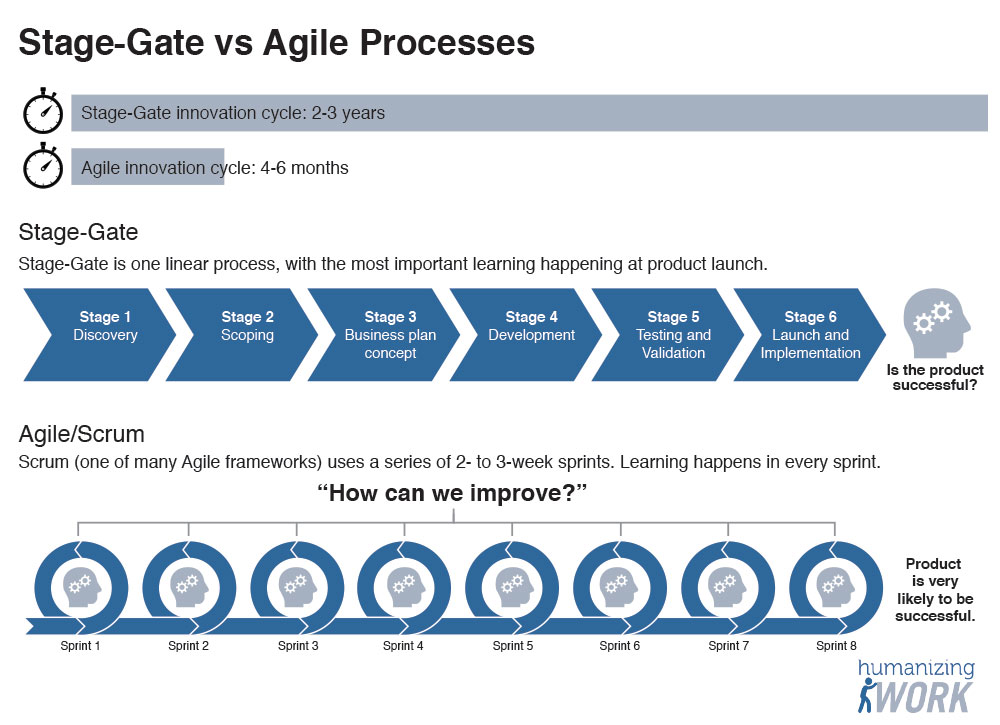How to Give a Great Sprint Demo
Exciting. Entertaining. Do these words describe your sprint review meetings? Or are boring and unfocused more accurate? Here are tips and best practices for a reliably good sprint review (demo). Read More
Exciting. Entertaining. Do these words describe your sprint review meetings? Or are boring and unfocused more accurate? Here are tips and best practices for a reliably good sprint review (demo). Read More

inQB8 team increases new-product throughput by 10x Executive Summary: 3 Key Differences and Benefits of Agile CPG Innovation 3 Key differences from traditional CPG: Cross-functional groups work as full-time dedicated teams. Rapid test and learn cycles. Focus on… Read More
How long should your sprints be? Generally, 1-2 weeks, with a preference towards a shorter sprint. But that’s not what I’m writing about today. I want to introduce you to the magic of 1-day sprints. Read More
I encourage my clients to find and focus on the core value of whatever they’re creating. What is it that doesn’t yet exist in the world but should? Go there first. Don’t defer that value. “But we need to create the infrastructure for that first, don’t we?” they often reply, by which they mean things like hardware, foundational technology layers, architecture, capabilities like user management, etc. Read More
We're often asked which day or days are best for scheduling the Sprint Planning, Review, and Retrospective meetings. Read More
Change on software projects is expensive; it leads to wasteful rework. Change is risk. We can deal with risk one of two ways. We can reduce the likelihood of the negative event occurring. Or we can reduce the impact of the negative event when it does occur. (Of course, the two can often be combined.) The traditional approach says, "Let's put more effort and thought in up-front and avoid that expensive change." (That is, let's prevent the negative event from occurring.) The problem, as decades of experience have shown, is we still can't seem to avoid change. Here's why: the kinds of change that plague software development can't be eliminated by thinking harder up front. Read More
As an organization transforms to an agile way of working, functional managers (e.g. a dev manager or a test manager) can feel lost. Many of their traditional responsibilities move to other roles or disappear altogether. How can functional managers continue to add value in an agile organization? Here are a few ideas… Read More
Atul Gawande is a surgeon and author who has written some excellent books and New Yorker articles reflecting on the state of modern medicine. Recently, his writing has gone beyond medicine in interesting ways. As he looks for lessons for medicine from other disciplines, he ends up with things to teach both medical professionals and skilled knowledge workers more generally. His book The Checklist Manifesto manages to be a riveting 224 pages on what ought to be one of the least interesting topics possible: the checklist. So I was intrigued to see a link to a New Yorker article from Dr. Gawande on my own specialty, coaching. It's as good as I might have hoped. Read More
The task board is a simple, yet powerful, tool for Scrum teams. As a coach, I can tell a lot about a team just by looking at their task board in the middle of a sprint. If your Scrum team is in the same location, I can't think of a good reason why you wouldn't want to build and use a task board. Here's how to build a basic task board, various ways to enhance it to convey more information, and some analysis of the many things you can learn from this simple tool. Read More
As a coach, I'm frequently told, "Our sprint length is too short. We want to change it from X to Y weeks." The time box—the sprint in Scrum, the iteration in XP and other iterative methods—is one of the most powerful tools in agile software development for revealing problems in a team or organization. Notice I said reveal, not fix. I've seen a few cases where the sprint length really was too short. More often, though, the feeling that the sprint is too short is a sign of deeper problems. Lengthening the sprint might push these problems back under the surface, but it's unlikely to actually solve them. Before you increase your sprint length, ask "Why?" a few times to see if you have any of the following underlying issues, and try to deal with those first. Maybe your sprint really is too short. But don't start there, lest you miss an opportunity to improve. Read More